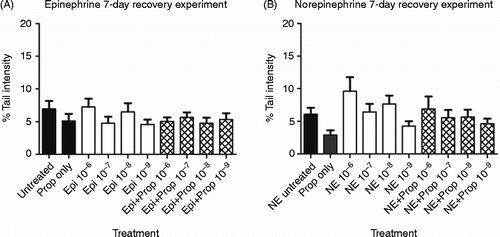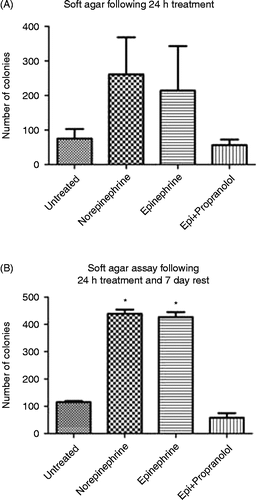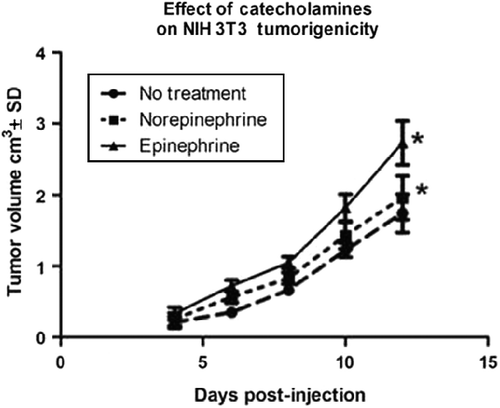Figures & data
Figure 1. Effect of 24-h exposure to stress hormones on DNA damage. NIH 3T3 cells were incubated in the presence or absence of (A) epinephrine or (B) norepinephrine for 24 h, and DNA damage was measured by the comet assay. In some experiments, cells were pre-treated for 30 min with 10− 6 M propranolol prior to treatment with the stress hormones. Results are expressed as mean% tail intensity ± SD. Asterisk (*) indicates the significant increase compared to that of untreated control (p < 0.05) using a one-way ANOVA with Tukey's post-hoc analyses. Each experiment was performed twice, and 100 cells were analyzed in each comet assay. Prop, propranolol; Epi, epinephrine; NE, norepinephrine.

Figure 2. Photographs of NIH 3T3 cells following comet assay. NIH 3T3 cells were untreated or treated (24 h) with stress hormones (epinephrine or norepinephrine) at 10− 7 M in the presence or absence of 10− 6 M propranolol. Arrows point to examples of comet tails. All pictures were taken at 50 × . Bars equal 50 μm. Epi, epinephrine; Norepi, norepinephrine; Prop, propranolol.

Figure 3. Effect of 24-h exposure to stress hormones on DNA damage followed by a 7-day rest period. NIH 3T3 cells were incubated in the presence or absence of (A) epinephrine or (B) norepinephrine for 24 h, followed by a 7-day rest period, and DNA damage was measured by the comet assay. In some experiments, cells were pre-incubated for 30 min with 10− 6 M propranolol. Each experiment was performed twice, and 100 cells were analyzed in each comet assay. Results are expressed as mean% tail intensity ± SD. No significant differences were found with one-way ANOVA. Pro, propranolol; Epi, epinephrine; NE, norepinephrine.

Figure 4. Effect of 24-h exposure to stress hormones on cell transformation. NIH 3T3 cells were incubated in the presence or absence of epinephrine (Epi) or norepinephrine (10− 7 M) for (A) 24 h or (B) 24 h followed by a 7-day rest period, and the transformed phenotype was measured by a soft agar colony assay. In some experiments, cells were pre-incubated for 30 min with 10− 6 M propranolol. Each experiment was performed twice. Results are expressed as mean ± SD. Asterisk (*) indicates the significant increase compared with that of untreated control (p < 0.05) using a one-way ANOVA with Tukey's post-hoc analyses. Epi, epinephrine.

Figure 5. Effect of stress hormones on tumor progression of NIH 3T3 cells. NIH 3T3 cells were incubated in the presence or absence of epinephrine or norepinephrine (10− 6 M) for 24 h, trypsinized, and 5 × 105 cells were injected subcutaneously into the flanks of Balb/c nude mice (four mice per group). Results are presented as mean tumor volume ± SD; mice were removed from study if tumor volume reached 4 cm3. Asterisk (*) indicates the significant increase compared with that of control (p = 0.01) using a repeated measures ANOVA.

